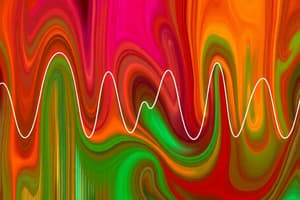Podcast
Questions and Answers
Where did the Roman soldiers nail Jesus to the cross?
Where did the Roman soldiers nail Jesus to the cross?
- Jericho
- Bethlehem
- Nazareth
- Calvary (correct)
According to the Gospels, Roman soldiers gambled for Jesus' clothes while he was on the cross.
According to the Gospels, Roman soldiers gambled for Jesus' clothes while he was on the cross.
True (A)
According to biblical accounts, how many thieves were crucified alongside Jesus?
According to biblical accounts, how many thieves were crucified alongside Jesus?
two
According to the Gospel of John, Jesus entrusted his mother, Mary, to the apostle ________.
According to the Gospel of John, Jesus entrusted his mother, Mary, to the apostle ________.
Which of these figures took Jesus' body down from the cross and buried it?
Which of these figures took Jesus' body down from the cross and buried it?
According to the Christian faith, what did Jesus sacrifice himself for?
According to the Christian faith, what did Jesus sacrifice himself for?
The cross is viewed as a sign of death and defeat throughout Christianity.
The cross is viewed as a sign of death and defeat throughout Christianity.
What does the text claim Jesus did by extending his arms on the cross, showing his love for us?
What does the text claim Jesus did by extending his arms on the cross, showing his love for us?
According to the Gospels, Jesus' death atoned for all sin: _________ sin and all our personal sins.
According to the Gospels, Jesus' death atoned for all sin: _________ sin and all our personal sins.
What is the significance of the cross in Christianity?
What is the significance of the cross in Christianity?
Who were the fishermen called to be apostles alongside St. John?
Who were the fishermen called to be apostles alongside St. John?
St. John was martyred along with the other apostles.
St. John was martyred along with the other apostles.
What writings is St. John credited with writing?
What writings is St. John credited with writing?
St. John's feast day is celebrated on _________.
St. John's feast day is celebrated on _________.
What did God ask the Israelites to sacrifice on the night they escaped slavery in Egypt?
What did God ask the Israelites to sacrifice on the night they escaped slavery in Egypt?
The Passover meal commemorates the Israelites' escape from slavery in Egypt.
The Passover meal commemorates the Israelites' escape from slavery in Egypt.
How did God's people recognize the houses he passed over during the escape from Egypt?
How did God's people recognize the houses he passed over during the escape from Egypt?
Some Jewish leaders wanted to get rid of Jesus because he seemed to act against what they ______.
Some Jewish leaders wanted to get rid of Jesus because he seemed to act against what they ______.
What event is commemorated during the Triduum?
What event is commemorated during the Triduum?
The Triduum includes Holy Thursday, Good Friday, and Easter Sunday.
The Triduum includes Holy Thursday, Good Friday, and Easter Sunday.
After their meal, which garden did Jesus and the apostles go to?
After their meal, which garden did Jesus and the apostles go to?
In the garden, Jesus asked the apostles to ___________, and he went on further by himself, filled with sorrow.
In the garden, Jesus asked the apostles to ___________, and he went on further by himself, filled with sorrow.
Who helped Jesus carry his cross up Mount Calvary?
Who helped Jesus carry his cross up Mount Calvary?
According to the text we call Jesus the Redeemer because slaves could be freed if someone paid for them, and he did that for us.
According to the text we call Jesus the Redeemer because slaves could be freed if someone paid for them, and he did that for us.
Match the following events with the day they are commemorated during the Triduum:
Match the following events with the day they are commemorated during the Triduum:
Flashcards
Death of Jesus
Death of Jesus
Roman soldiers nailed Jesus' hands and feet to the cross on Calvary. He was crucified between two thieves.
Jesus' words of forgiveness
Jesus' words of forgiveness
On the cross, Jesus said, "Father, forgive them; for they do not know what they are doing" (Lk 23:34).
Jesus' feeling of abandonment
Jesus' feeling of abandonment
On the cross, Jesus said, "My God, my God, why have you forsaken me?" (Mk 15:34 from Psalm 22).
Jesus' physical suffering
Jesus' physical suffering
Signup and view all the flashcards
Jesus' declaration of completion
Jesus' declaration of completion
Signup and view all the flashcards
Why did Jesus die?
Why did Jesus die?
Signup and view all the flashcards
Jesus' crime
Jesus' crime
Signup and view all the flashcards
Reality of Jesus' death
Reality of Jesus' death
Signup and view all the flashcards
Jesus' Sign of Love
Jesus' Sign of Love
Signup and view all the flashcards
Reconciliation through Jesus
Reconciliation through Jesus
Signup and view all the flashcards
The Lamb of God
The Lamb of God
Signup and view all the flashcards
A Holy Week Betrayal
A Holy Week Betrayal
Signup and view all the flashcards
The Bronze Serpent
The Bronze Serpent
Signup and view all the flashcards
Stations of the Cross
Stations of the Cross
Signup and view all the flashcards
The Last Supper
The Last Supper
Signup and view all the flashcards
The Triduum
The Triduum
Signup and view all the flashcards
The Suffering of Jesus
The Suffering of Jesus
Signup and view all the flashcards
Jesus the Redeemer
Jesus the Redeemer
Signup and view all the flashcards
St. John
St. John
Signup and view all the flashcards
Study Notes
The Laplace Transform Definition
- Defined for real numbers $t \geq 0$.
- Denoted as $F(s) = \mathcal{L} {f(t)} = \int_{0}^{\infty} e^{-st} f(t) dt$.
- $s$ is a complex number frequency parameter where $s = \sigma + j\omega$.
Region of Convergence (ROC)
- Exists when the defining integral converges.
- Convergence occurs when $Re(s) > a$ for some real number $a$.
- Region of convergence is given by $Re(s) > a$.
Linearity
- The Laplace transform of a linear combination of functions is the linear combination of their Laplace transforms.
- $\mathcal{L} {af(t) + bg(t)} = a\mathcal{L} {f(t)} + b\mathcal{L} {g(t)}$.
Time Scaling
- $\mathcal{L} {f(at)} = \frac{1}{|a|} F(\frac{s}{a})$.
Time Shifting
- $\mathcal{L} {f(t - a)u(t - a)} = e^{-as}F(s)$.
- $u(t)$ is the Heaviside step function.
Shifting in the s-Domain
- $\mathcal{L} {e^{at}f(t)} = F(s - a)$.
Differentiation in the Time Domain
- First derivative: $\mathcal{L} {\frac{d}{dt}f(t)} = sF(s) - f(0)$.
- Second derivative: $\mathcal{L} {\frac{d^2}{dt^2}f(t)} = s^2F(s) - sf(0) - f'(0)$.
- nth derivative: $\mathcal{L} {\frac{d^n}{dt^n}f(t)} = s^nF(s) - s^{n-1}f(0) - s^{n-2}f'(0) -... - f^{(n-1)}(0)$.
Integration in the Time Domain
- $\mathcal{L} {\int_{0}^{t} f(\tau) d\tau} = \frac{F(s)}{s}$.
Differentiation in the s-Domain
- $\mathcal{L} {tf(t)} = -\frac{d}{ds}F(s)$.
- $\mathcal{L} {t^nf(t)} = (-1)^n \frac{d^n}{ds^n}F(s)$.
Convolution
- $\mathcal{L} {(f * g)(t)} = F(s)G(s)$.
- $(f * g)(t) = \int_{0}^{t} f(\tau)g(t - \tau) d\tau$.
Initial Value Theorem
- $\lim_{t \to 0} f(t) = \lim_{s \to \infty} sF(s)$.
Final Value Theorem
- $\lim_{t \to \infty} f(t) = \lim_{s \to 0} sF(s)$.
Common Laplace Transforms
Unit Impulse
- $f(t) = \delta(t)$.
- $F(s) = 1$.
- ROC: All s.
Unit Step
- $f(t) = u(t)$.
- $F(s) = \frac{1}{s}$.
- ROC: $Re(s) > 0$.
Ramp
- $f(t) = t$.
- $F(s) = \frac{1}{s^2}$.
- ROC: $Re(s) > 0$.
Exponential
- $f(t) = e^{at}$.
- $F(s) = \frac{1}{s - a}$.
- ROC: $Re(s) > Re(a)$.
Sine
- $f(t) = \sin(\omega t)$.
- $F(s) = \frac{\omega}{s^2 + \omega^2}$.
- ROC: $Re(s) > 0$.
Cosine
- $f(t) = \cos(\omega t)$.
- $F(s) = \frac{s}{s^2 + \omega^2}$.
- ROC: $Re(s) > 0$.
Hyperbolic Sine
- $f(t) = \sinh(at)$.
- $F(s) = \frac{a}{s^2 - a^2}$.
- ROC: $Re(s) > |a|$.
Hyperbolic Cosine
- $f(t) = \cosh(at)$.
- $F(s) = \frac{s}{s^2 - a^2}$.
- ROC: $Re(s) > |a|$.
Damped Sine
- $f(t) = e^{-at}\sin(\omega t)$.
- $F(s) = \frac{\omega}{(s + a)^2 + \omega^2}$.
- ROC: $Re(s) > -a$.
Damped Cosine
- $f(t) = e^{-at}\cos(\omega t)$.
- $F(s) = \frac{s + a}{(s + a)^2 + \omega^2}$.
- ROC: $Re(s) > -a$.
t to the power of n
- $f(t) = t^n$.
- $F(s) = \frac{n!}{s^{n+1}}$.
- ROC: $Re(s) > 0$.
Physics: Vectors
Vector Sum - Graphical Method
- Place vectors A and B sequentially, keeping magnitude, direction, and sense.
- Resultant R is from the origin of the first to the end of the last vector.
Vector Sum - Analytical Method
- Formulas for rectangular components of a vector.
- $A_x = A \cos \theta$.
- $A_y = A \sin \theta$.
- Sum by components:
- $R_x = A_x + B_x +...$
- $R_y = A_y + B_y +...$
- $R = \sqrt{R_x^2 + R_y^2}$.
- $\theta = \arctan \frac{R_y}{R_x}$.
Dot Product (Scalar)
- Represented as $\vec{A} \cdot \vec{B} = AB \cos \theta = A_x B_x + A_y B_y + A_z B_z$.
- The result is a scalar.
Cross Product (Vector)
- Represented as $\vec{A} \times \vec{B} = AB \sin \theta \hat{n}$.
- Calculated as the determinant with unit vectors i, j, k:
- $\vec{A} \times \vec{B} = \begin{vmatrix} \hat{i} & \hat{j} & \hat{k} \ A_x & A_y & A_z \ B_x & B_y & B_z \end{vmatrix} = (A_y B_z - A_z B_y)\hat{i} + (A_z B_x - A_x B_z)\hat{j} + (A_x B_y - A_y B_x)\hat{k}$.
- The result is a vector, perpendicular to the plane formed by vectors A and B, sense determined by the right-hand rule.
Semiconductor Energy Bands and Charge Carriers
Energy Bands
- E vs. k Diagram: Solutions to Schrödinger's equation in a crystal lattice.
- Metals: Fermi level within an allowed band (partially filled).
- Semiconductors: Fermi level in a band gap (full valence, empty conduction).
- Insulators: Fermi level in a large band gap.
Intrinsic Semiconductor
- Perfect crystal, no impurities or defects.
- Silicon (Si) and Germanium (Ge) are Group IV elements, covalently bonded to four neighbors.
- At $T = 0K$, valence band is full, conduction band is empty.
- Intrinsic Carrier Concentration: $n = p = n_i$ at $T > 0K$ (electron-hole pairs).
- $n_i$ increases exponentially with temperature.
- Fermi level ($E_F$) is near the middle of the band gap ($E_g$).
- $n_i = \sqrt{N_c N_v} e^{-E_g / 2kT}$
- $N_c$ is the effective density of states in the conduction band.
- $N_v$ is the effective density of states in the valence band.
- $E_g$ is the band gap energy.
- $k$ is Boltzmann's constant.
- $T$ is the temperature in Kelvin.
Extrinsic Semiconductor
- Doping: Intentionally adding impurities to control electrical properties.
- n-type: Doped with donor impurities (more valence electrons), $n > n_i$, $E_F$ closer to $E_c$.
- p-type: Doped with acceptor impurities (fewer valence electrons), $p > n_i$, $E_F$ closer to $E_v$.
- Compensation: Both donors and acceptors present; conductivity type determined by higher concentration.
Carrier Transport Phenomena
- Drift: Motion of carriers due to an electric field.
- $J_{drift} = \sigma E = q(n\mu_n + p\mu_p)E$
- $\sigma$ is the conductivity.
- $E$ is the electric field.
- $q$ is the elementary charge.
- $n$ and $p$ are electron and hole concentrations.
- $\mu_n$ and $\mu_p$ are electron and hole mobilities.
- Diffusion: Movement from high to low concentration.
- $J_{diffusion} = qD_n \frac{dn}{dx} - qD_p \frac{dp}{dx}$
- $D_n$ and $D_p$ are electron and hole diffusion coefficients.
- $\frac{dn}{dx}$ and $\frac{dp}{dx}$ are electron and hole concentration gradients.
- Einstein Relation: $\frac{D_n}{\mu_n} = \frac{D_p}{\mu_p} = \frac{kT}{q}$.
- $k$ is Boltzmann's constant.
- $T$ is the temperature in Kelvin.
- $q$ is the elementary charge.
Algorithmic Complexity
Purpose
- The ability to quantify the resources that an algorithm requires, like time or memory.
- The ability to compare efficiencies between algorithms.
- The ability to predict how an algorithm will behave given scaling input sizes.
Uses
- Can assist in choosing the correct algorithm.
- Can help optimize code.
- Helps to understand the limits of computation.
Understanding Big-O Notation
- The variable $f(n) = O(g(n))$ if there are constants $c$ and $n_0$ such that $f(n) \le cg(n)$ when $n \ge n_0$.
- It is that $f(n)$ does not grow any faster than $g(n)$ does as $n$ grows.
- $n^2 + n = O(n^2)$.
- $100n = O(n)$.
- $\log(n) = O(n)$.
Common Complexities
- Constant ($O(1)$): It takes the same amount of time to perform the function no matter the array size (Accessing array element).
- Logarithmic ($O(log n)$): Time increases proportionally to the logarithm of the input size (using the "Binary Search" algorithm).
- Linear ($O(n)$): Time increases in direct proportion to input size (looping through an array).
- Log-Linear ($O(n log n)$): Time increases proportionally to the input size times the logarithm of the input size (using the "Merge Sort" algorithm).
- Quadratic ($O(n^2)$): Time increases proportionally to the square of the input size (Nested loops).
- Cubic ($O(n^3)$): Time increases proportionally to the cube of the input size (Matrix multiplication).
- Exponential ($O(2^n)$): Time doubles with each additional input (Traveling salesman (naive)).
Simplifying Big-O Expressions
- Delete lower order terms: $n^2 + n \rightarrow n^2$.
- Delete constact factors: $100n \rightarrow n$.
- Ensure use the simplest expression possible: $O(n^2 + n) \rightarrow O(n^2)$.
- $O(log_a n) = O(log_b n)$.
Performance of Algorithms
- Linear Search is $O(n)$.
- Binary Search is $O(log n)$.
- Bubble Sort is $O(n^2)$.
- Merge Sort: is $O(n log n)$.
Important Caveats
- Big-O describes the asymptotic behaviors of algorithms.
- Constant factors can matter.
- Big-O does not tell anything about the actual runtme of algorithms.
- Considers "Worst-Case" vs "Average-Case".
Algorithmic Game Theory
What is Game Theory?
- Game theory is the study of mathematical models of strategic interactions among rational agents.
- Cooperative: Focus on groups of players that form coalitions.
- Non-Cooperative: Focus on individual players and their strategies.
Normal-Form Games
- Described via a payoff matrix.
- A tuple $(N, A, u)$, where:
- $N$ is a finite set of $n$ players, indexed by $i$.
- $A = A_1 \times \dots \times A_n$, where $A_i$ is a finite set of actions available to player $i$. Each $a = (a_1, \dots, a_n) \in A$ is an action profile.
- $u = (u_1, \dots, u_n)$, where $u_i : A \mapsto \mathbb{R}$ is a real-valued utility function for player $i$. $u_i(a)$ specifies the payoff to player $i$ when the action profile is $a$.
Prisoner's Dilemma Example
- Suspects arrested, lacking conviction evidence unless one confesses.
- If one confesses and the other doesn't, the confessor is freed, the other jailed for 3 years.
- If both confess, both jailed for 2 years.
- If neither confesses, both jailed for 1 year.
Strategies in Game Theory
- Pure Strategy: An action $a_i \in A_i$.
- Mixed Strategy: Probability distribution over $A_i$.
- Let $S_i$ denote the set of all possible mixed strategies for player $i$.
- For $s_i \in S_i$, let $s_i(a_i)$ be the probability of playing action $a_i \in A_i$ under mixed strategy $s_i$.
- Strategy Profile: A tuple $s = (s_1, \dots, s_n)$, where $s_i \in S_i$ is a mixed strategy for player $i$.
- Let $S = S_1 \times \dots \times S_n$ denote the set of all strategy profiles.
Expected Utility
- The expected utility of player $i$ under strategy profile $s$ is:
- $u_i(s) = \sum_{a \in A} u_i(a) \prod_{j \in N} s_j(a_j)$.
Nash Equilibrium
- A strategy profile $s^* \in S$ is a Nash Equilibrium if, for every player $i \in N$ and every strategy $s_i \in S_i$:
- $u_i(s_i^, s_{-i}^) \ge u_i(s_i, s_{-i}^)$, where $s_{-i}^$ denotes the strategies of all players except $i$.
- No player has an incentive to unilaterally deviate from their strategy in a Nash Equilibrium.
- The only Nash Equilibrium within the Prisoners dilemma is (Defect, Defect).
Existence Theorem
- Every normal-form game with a finite number of players and actions has at least one Nash Equilibrium, possibly in mixed strategies.
Studying That Suits You
Use AI to generate personalized quizzes and flashcards to suit your learning preferences.




